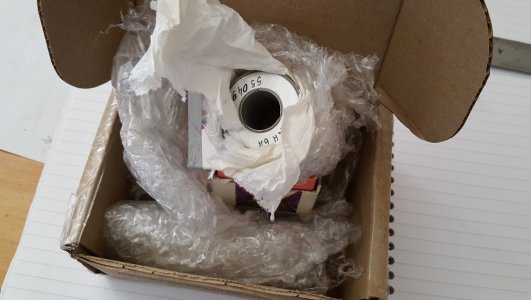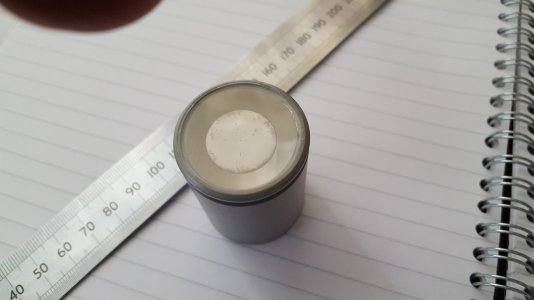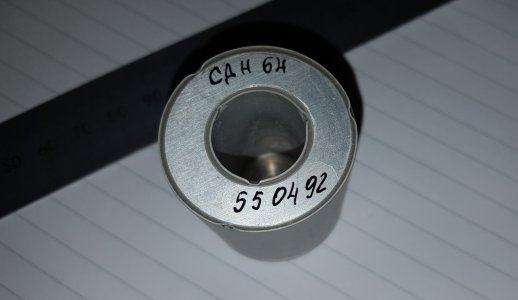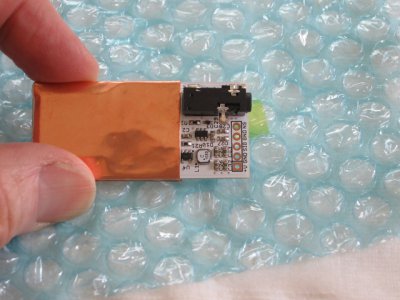-
Welcome back Guest! Did you know you can mentor other members here at H-M? If not, please check out our Relaunch of Hobby Machinist Mentoring Program!
You are using an out of date browser. It may not display this or other websites correctly.
You should upgrade or use an alternative browser.
You should upgrade or use an alternative browser.
Needing more than a spark test?
- Thread starter graham-xrf
- Start date
- Joined
- Jul 28, 2017
- Messages
- 2,367
That's the filter network used to reduce switching noise from the switching regulator. The regulator steps the input voltage (3-9V) up to around 30V to get the x-ray detector into its proper operating range. We WANT this node to have a big capacitor on it.It's the output stage to the connection port which you mentioned above with a 100k resistor and 1uF capacitor,
In normal operation the detector diode is operating in its avalanche breakdown mode. In this mode, carriers produced by an x-ray photon are amplified by a process called "impact ionization". It's similar to (but not exactly like) what happens in a photomultiplier tube, but doesn't require the high voltage and resistor divider chain that a PMT does. There's no real magic here -- the electric fields for the two devices are similar, but since the PMT dynodes are spaced further apart, that means the applied _voltage_ must be higher.
- Joined
- Jul 28, 2017
- Messages
- 2,367
I ordered one of the detector boards from Sparkfun. It should be interesting to play with. At this point I'm thinking about making something similar to the standalone Arduino-based MCA, but with a better peak-hold. I suspect the Theremino group's claims regarding the necessity of a 16 bit ADC are due to the fact that even the amplified pulses are a small fraction of the ADC's dynamic range (so they're throwing away a lot of effective resolution). Only one way to find out....
I also have ordered some Americium smoke detector capsules but they're on a slow boat from China so they are several weeks out. The 1/8" thick lead sheet I purchased from ebay arrived last week. I haven't ordered any mirror-silvering chemicals yet, that's something that can happen once the other components are assembled and verified to be working properly.
I also have ordered some Americium smoke detector capsules but they're on a slow boat from China so they are several weeks out. The 1/8" thick lead sheet I purchased from ebay arrived last week. I haven't ordered any mirror-silvering chemicals yet, that's something that can happen once the other components are assembled and verified to be working properly.
- Joined
- Jul 28, 2017
- Messages
- 2,367
I don't know if it's my particular version/configuration of Linux, but so far I have been unable to get Theremino_MCA to run under Wine. I get a slew of error messages and then Wine aborts. I'd be interested to hear about other folks' experiences in this regard.
On the other hand, "PRA" does seem to run OK under Wine, although I haven't tried it on a sound file yet.
For the ultimate in portability, pyMCA probably is the way to go -- Python runs natively on all sorts of platforms. I haven't messed with this one yet, so I don't know if it can be used in combination with a sound card or not.
On the other hand, "PRA" does seem to run OK under Wine, although I haven't tried it on a sound file yet.
For the ultimate in portability, pyMCA probably is the way to go -- Python runs natively on all sorts of platforms. I haven't messed with this one yet, so I don't know if it can be used in combination with a sound card or not.
- Joined
- May 27, 2016
- Messages
- 3,469
When the text on the package is Cyrillic..
Yep - then you know the snail-mail from Ukraine finally made it. I now have a Na(Tl) Scintillator. Of the batch I worked my way through among the original offerings, this was the only one that did not have water in it, so I bought it.
Packed in multiple layers of bubble-wrap, it was a bit of a struggle to get at.

Very interesting! Getting a look at the glass end that butts onto the photomultiplier tube, you see the bottom of the aluminium can, apparently all the way onto the other side of the window, or with only a very thin amount of crystal, if any, between it and the glass. The colour is of silver, that definite silvery-white.
I know that one can deposit silver from grape-sugar and other reduction solutions onto almost anything, although the layer is so thin it is fragile. It used to be painted over with something red for mirrors. It definitely looks like silver down there.
This crystal is pristine, no sign of yellowing, nor any bubbles.

I guess the crystal lights up, and the light goes out from the ring region around the bottom of the can

Turning it over, the "input" end shows the deep metal can that you can stick the pinky into and touch the bottom.
It is almost as if the thing is built to "surround" some sample or material placed into the can with scintillator crystal all around it.
However this works, it is clear that if X-rays are coming at it from some surface being bombarded by gamma rays, then getting any to go sideways through the tube into the crystal might be awkward. X-rays aimed directly down the can will not encounter much crystal unless there is a bit between the bottom of the can and the output window. Any other X-rays, if started outside of the can would have to travel through the walls of the can at a steep angle, nothing like "normal" incidence.
Of course, I may have this completely wrong!
Perhaps the X-Rays can enter the crystal by coming through the thin aluminium larger outside walls from all sides, and the central aluminium can is maybe there so it can maybe be held on a support rod up the middle (far fetched idea)!
Then again - what colour is clean Tellurium? Apparently silver-white "metalloid", meaning "somewhere in between" metal and non-metal. A semiconductor along with friends boron, germanium, silicon, arsenic, selenium and antimony.
However this works, I don't yet understand it. The build has that charm of military lab style markings done with a mapping pen and Indian ink, then varnished over. Very typical of British and US labs in the past, and may even still be done that way on prototypes - I don't know.
Even if this stuff does not feature in what we end up with, it is going to be a fun one-off. As I have learned more, my preference now has evolved to some kind of photodiode thing, and if the "direct to diode" X-Ray detection photodiode sans scintillator can work out, that is what I would consider ideal.
Yep - then you know the snail-mail from Ukraine finally made it. I now have a Na(Tl) Scintillator. Of the batch I worked my way through among the original offerings, this was the only one that did not have water in it, so I bought it.
Packed in multiple layers of bubble-wrap, it was a bit of a struggle to get at.

Very interesting! Getting a look at the glass end that butts onto the photomultiplier tube, you see the bottom of the aluminium can, apparently all the way onto the other side of the window, or with only a very thin amount of crystal, if any, between it and the glass. The colour is of silver, that definite silvery-white.
I know that one can deposit silver from grape-sugar and other reduction solutions onto almost anything, although the layer is so thin it is fragile. It used to be painted over with something red for mirrors. It definitely looks like silver down there.
This crystal is pristine, no sign of yellowing, nor any bubbles.

I guess the crystal lights up, and the light goes out from the ring region around the bottom of the can

Turning it over, the "input" end shows the deep metal can that you can stick the pinky into and touch the bottom.
It is almost as if the thing is built to "surround" some sample or material placed into the can with scintillator crystal all around it.
However this works, it is clear that if X-rays are coming at it from some surface being bombarded by gamma rays, then getting any to go sideways through the tube into the crystal might be awkward. X-rays aimed directly down the can will not encounter much crystal unless there is a bit between the bottom of the can and the output window. Any other X-rays, if started outside of the can would have to travel through the walls of the can at a steep angle, nothing like "normal" incidence.
Of course, I may have this completely wrong!
Perhaps the X-Rays can enter the crystal by coming through the thin aluminium larger outside walls from all sides, and the central aluminium can is maybe there so it can maybe be held on a support rod up the middle (far fetched idea)!
Then again - what colour is clean Tellurium? Apparently silver-white "metalloid", meaning "somewhere in between" metal and non-metal. A semiconductor along with friends boron, germanium, silicon, arsenic, selenium and antimony.
However this works, I don't yet understand it. The build has that charm of military lab style markings done with a mapping pen and Indian ink, then varnished over. Very typical of British and US labs in the past, and may even still be done that way on prototypes - I don't know.
Even if this stuff does not feature in what we end up with, it is going to be a fun one-off. As I have learned more, my preference now has evolved to some kind of photodiode thing, and if the "direct to diode" X-Ray detection photodiode sans scintillator can work out, that is what I would consider ideal.
- Joined
- Mar 25, 2013
- Messages
- 4,613
I think what you have there is a scintillator crystal from a dose calibrator or well counter. The idea is you put a dose of a gamma emitter down into the hole in the crystal so it is surrounded by scintillator material. The counts then correspond to the dose in mCi. These are commonly used in nuclear medicine labs.
Robert
Robert
- Joined
- Jul 28, 2017
- Messages
- 2,367
I second Robert's conjecture. I don't know how the well geometry, if used as-is, will affect its usefulness for XRF, but I just had an interesting thought. The issue is how to collect the x-rays created by the Americium gammas, without hitting the PMT's photodetector with the primary gamma rays. Put a lead "puck" on the bottom of the well to block the primaries. Dump your sample into the well (on top of the lead) and place the Americium source over the well opening. A lead collimator "pinhole" will be needed to keep the primaries from hitting the aluminum walls and, of course, the scintillator. A ruler can be used as the "computer" to get the geometry of the source and collimator right. It....could....work..... (as Young Frankenstein said). Of course, that show was entirely factual, right? 
That sort of setup could very well be more efficient than the crystal-stuck-to-a-PMT approach we've seen in other DIY XRF builds. I wouldn't suggest this approach except for the fact that you indicated the well has an aluminum liner, hopefully robust enough to handle rough metal samples being dumped into it. Of course, the aluminum has to be thin enough to not significantly attenuate the ~6KeV photons emitted by V, Mn, Fe, Cr and Co.
The thallium component in the scintillator is a dopant to increase the efficiency of light production. According to Wikipedia, Thallium Iodide is used in trace amounts to dope NaI scintillators. Its room temperature crystal form is light yellow in color, and is unusual because its halides are relatively insoluble in water (and thus not hygroscopic). So any silvery colors you see inside your scintillator module probably are there to improve the coupling of light into the PMT, not because of the Tl.
FYI, the mirror-silvering kits available from AngelGuilding include a bottle of paint to protect the silver from oxidation and scratches.
My x-ray diode hasn't arrived yet, darn it. I'm really interested to see how it pans out.

That sort of setup could very well be more efficient than the crystal-stuck-to-a-PMT approach we've seen in other DIY XRF builds. I wouldn't suggest this approach except for the fact that you indicated the well has an aluminum liner, hopefully robust enough to handle rough metal samples being dumped into it. Of course, the aluminum has to be thin enough to not significantly attenuate the ~6KeV photons emitted by V, Mn, Fe, Cr and Co.
The thallium component in the scintillator is a dopant to increase the efficiency of light production. According to Wikipedia, Thallium Iodide is used in trace amounts to dope NaI scintillators. Its room temperature crystal form is light yellow in color, and is unusual because its halides are relatively insoluble in water (and thus not hygroscopic). So any silvery colors you see inside your scintillator module probably are there to improve the coupling of light into the PMT, not because of the Tl.
FYI, the mirror-silvering kits available from AngelGuilding include a bottle of paint to protect the silver from oxidation and scratches.
My x-ray diode hasn't arrived yet, darn it. I'm really interested to see how it pans out.
- Joined
- Jul 28, 2017
- Messages
- 2,367
I thought I had posted this earlier, but guess I need to do it again. My X100-7 based "geiger counter" arrived a little while ago. It is very compact. See below:

The copper foil is wrapped around the detector, and probably is used to stop alpha particles. I don't see an electrical connection to it, so it probably is not a shield to reduce electrical noise pickup. The black thing on the upper right corner is a phone jack to interface it to a cell phone, but it sounds like the geiger counter app does't work on Samsung smartphones. For my purposes, I will remove the shield -- the whole thing is going to be inside a lead box anyway, so noise pickup shouldn't be an issue. I will have to tap into the analog output, but that is brought out to a 2 x 6 pad array on the back side of the board.
The package includes a box to house the board, and two brass sheets that are used to block beta particles so the device can be customized to only detect x-rays.
I worked up a model to simulate the circuit, to see if the output of the analog portion of the board is compatible with sound card-based MCA's, and it looks like it is. The pulse width is over 100us wide. The main question in my mind is the pulse amplitude. The datasheet for the X100-7 is completely silent regarding the magnitude of current pulses coming out of it. Examination of the schematic shows that the comparator trip voltages (to distinguish noise from real betas/gammas) are 2.69 V and 3.09 V respectively. The difference is about 300mV. My simulations indicate that a 100nA current pulse will result in a 300mV pulse coming out of the second amplifier. So a ballpark number is about 100nA -- but for our purposes that will vary, depending on the incoming x-ray energy.
The X100-7 is a special silicon PIN diode, and it is not operated in its avalanche mode like a SiPM. That's why they can get away with only a 27V bias applied to the diode. The actual voltage across the diode is lower yet. Again looking at the schematic, the DC voltage across the diode really is about 24V (this is due to the fact that the amplifiers are being operated in a single-supply mode).

The copper foil is wrapped around the detector, and probably is used to stop alpha particles. I don't see an electrical connection to it, so it probably is not a shield to reduce electrical noise pickup. The black thing on the upper right corner is a phone jack to interface it to a cell phone, but it sounds like the geiger counter app does't work on Samsung smartphones. For my purposes, I will remove the shield -- the whole thing is going to be inside a lead box anyway, so noise pickup shouldn't be an issue. I will have to tap into the analog output, but that is brought out to a 2 x 6 pad array on the back side of the board.
The package includes a box to house the board, and two brass sheets that are used to block beta particles so the device can be customized to only detect x-rays.
I worked up a model to simulate the circuit, to see if the output of the analog portion of the board is compatible with sound card-based MCA's, and it looks like it is. The pulse width is over 100us wide. The main question in my mind is the pulse amplitude. The datasheet for the X100-7 is completely silent regarding the magnitude of current pulses coming out of it. Examination of the schematic shows that the comparator trip voltages (to distinguish noise from real betas/gammas) are 2.69 V and 3.09 V respectively. The difference is about 300mV. My simulations indicate that a 100nA current pulse will result in a 300mV pulse coming out of the second amplifier. So a ballpark number is about 100nA -- but for our purposes that will vary, depending on the incoming x-ray energy.
The X100-7 is a special silicon PIN diode, and it is not operated in its avalanche mode like a SiPM. That's why they can get away with only a 27V bias applied to the diode. The actual voltage across the diode is lower yet. Again looking at the schematic, the DC voltage across the diode really is about 24V (this is due to the fact that the amplifiers are being operated in a single-supply mode).
- Joined
- Jul 28, 2017
- Messages
- 2,367
I am gratified to see some actual hardware! What's next???
R

